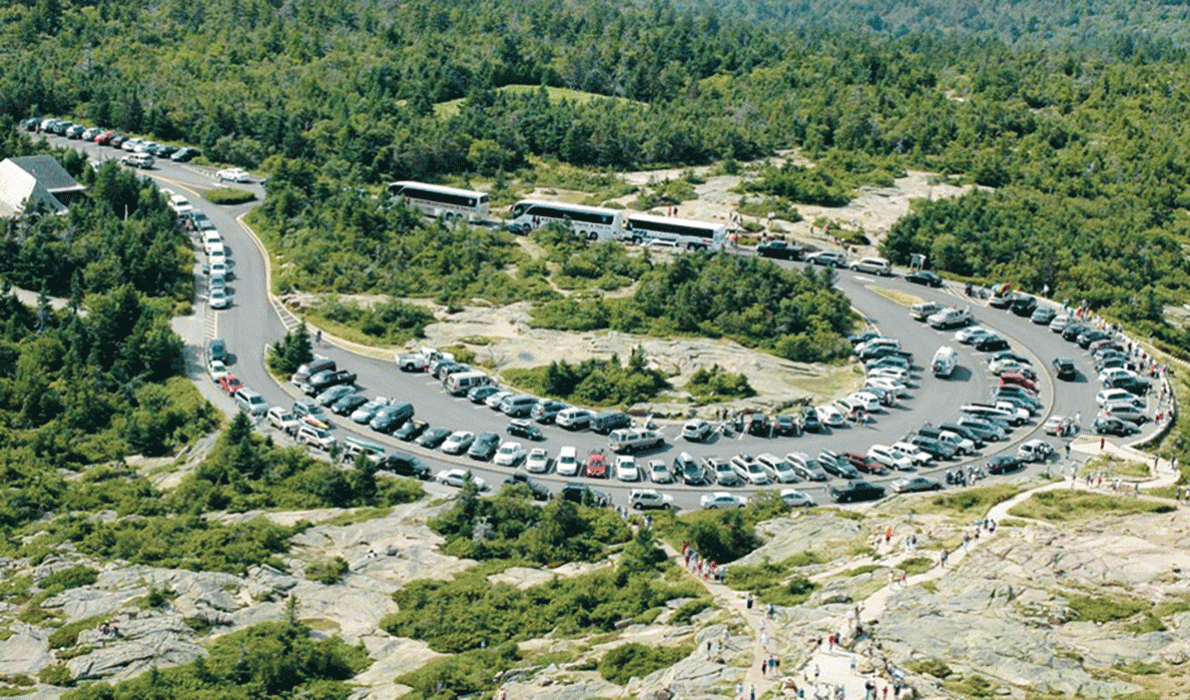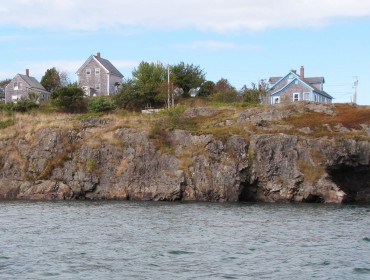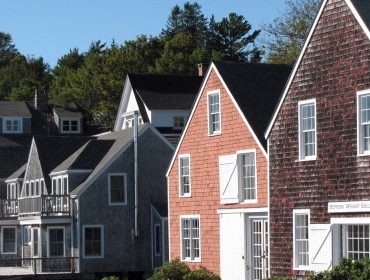Posted August 31, 2018
Last modified August 31, 2018
By Tom Walsh
The traffic tsunami inherent in Acadia National Park, which hosted a record 3.5 million visitors in 2017, has the town of Bar Harbor and the National Park Service coping with the conundrum of how best to accommodate seasonal parking for cars, trucks, tour buses, tourist trollies, recreational vehicles, and motorcycles.
The same concern confronts coastal cities as large as Portland and coastal towns as small and remote as Stonington, as well as many other tourist destinations along the Gulf of Maine coastline.
Bar Harbor has a year-round population of 5,400-plus. During warm weather, the local population swells to an estimated 38,000 residents, making it the seasonal third largest “city” in Maine. The jigsaw puzzle of how best to deal with the needs of both resident and tourist parking between mid-May and mid-October has been under formal discussion in Bar Harbor for 16 years. As the debate evolved, so did a problem that keeps getting worse. Between 2008 and 2018 there was 58 percent growth in visits to Acadia.
In 2012 the Bar Harbor Town Council created a local advisory committee to address congestion and parking issues and to explore the concept of construction of a parking garage within the existing town-owned “back yard” parking lot behind the Criterion Theater on Cottage Street, between Main and Rodick streets. In 2013 the town hired a consulting firm to study the costs and benefits of that and other strategies. The option of a 412-bay parking garage to be funded through a public-private partnership was eventually abandoned, due to lack of public support, with the focus shifting to the establishment of a paid meter, kiosk and permit parking system.
The town’s parking solutions task force eventually endorsed a parking strategy that included six “key” recommendations, including seasonal installation of electronic parking meters for 392 downtown parking spaces along Cottage Street, West Street, Mount Desert Street, and Firefly Lane. Also suggested was the introduction of paid parking kiosks within nine publicly-owned lots that collectively would accommodate users of nearly 400 spaces in and near the town center.
To meet the needs of local residents and employees of downtown businesses, the strategy also suggests free seasonal day-long permit parking on all other streets not targeted for meters. It also suggests free, 15-minute parking on Cottage Street in front of the post office and town office. The task force also recommends that 5 percent of the on-street and public parking lot spaces—40 spaces—be designated as free “resident only” parking. Fishermen would always park free in spaces near the docks.
After covering the installation costs of parking meters and kiosks and the expenses inherent in parking enforcement, the task force predicts the town will net an estimated $500,000 in parking revenue per year. Residents approved the plan at the June 5 town meeting, authorizing the town to sell up to $600,000 in municipal bonds to fund the costs of 400-plus electronic parking meters and kiosks, related software and hand-held electronic citation devices. By unanimous vote, the seven-member town council recommended approval of the bond referendum. Of the 1,713 voters who made it to the polls in June, 859 approved the bond sale, with another 719 voting against it.
ACADIA PARKING
Year after year, seasonal vehicular congestion within Acadia National Park has increased. With random and unregulated on-road parking, some say bicycling within the park has become hazardous. Beyond bumper-to-bumper traffic on the park’s two-lane Loop Road, there is always overwhelming demand for empty spaces within scarce parking lots. At peak times, several lots have been closed.
The worsening status quo has prompted the National Park Service (NPS) to generate options for public comment, its thinking laid out within a 242-page “draft transportation plan” not yet implemented. That plan proposes a timed-entry reservation system for parking along the park’s “must-see” destinations, including Loop Road, the Cadillac Mountain sunrise summit, the Jordan Pond House popover restaurant, Sand Beach, Thunder Hole, and the Sieur de Monts gardens.
The NPS is now evaluating 489 public feedback comments on its draft transportation plan. Given the tedious bureaucratic process inherent in approval of any NPS plan, parking planners involved at Acadia don’t anticipate any new parking strategy will be implemented until 2020.
PORTLAND PLANNING
Portland has been a seasonal, beaten-path, almost-there destination between sweltering urban Boston and the cooling offshore breezes of Bar Harbor for at least 100 years. Now bayside Portland’s growing reputation as a vibrant culinary mini-Mecca has placed new demands on short-term parking, a problem within the city’s downtown and its Old Port and eastern and central waterfront neighborhoods.
Enter stage left, new demand from high-end, harbor-view apartments and condos, a demand that brings with it a mixed bag of new parking issues.
Portland city planners still find themselves wading through a consultant’s year-old, 138-page micro-analysis of Portland’s parking morass. Long-winded and hyper-detailed, it notes that “challenges associated with parking are among the most pressing and frequent issues brought to the city by constituents.” Including visitors.
“Parking is a component of all planning and development situations,” said Bill Needelman, waterfront coordinator for Portland’s economic development efforts. “The situation is certainly exacerbated by summer travel, and we’re working on, through apps, improving information on parking availability.”
STONINGTON
The Hancock County lobster fishing community of Stonington, population of about 1,100, is adjacent to Deer Isle on Eggemoggin Reach. As an active working waterfront, Stonington has become a tourist destination for its busy and iconic lobster harbor, a step back in time. While the harbor is great for bucolic photos, where are all these seasonal photographers supposed to park?
“The biggest thing and most aggravating problem is no compliance in spaces that are clearly marked, like loading zones for delivery trucks,” said Kathleen Billings, Stonington’s town manager since 2007. “Most people try to obey the signs, but some just don’t care. To them, they’re just running in for a cup of coffee.”
Parking along the few spaces available on West Main Street is limited to four hours. Over the years the town has looked at the pros, cons, and expense of adding parking by acquiring and razing properties near the town center as they come up for sale. A ballfield not far from the harbor is available, so the town urges fishermen to park trap trailers there.
“I’ve looked over every frickin’ square inch of this town, looking for new parking,” Billings said. “I’m always trying to squeeze in more spaces safely. We have parking up on the hill, but nobody wants to walk a half-mile from a parking spot,” she said.
“We’re a destination for many different reasons,” Billings said. “Some come to look at lobster boats. Others because they have family or friends along the Reach, where maybe they came as kids. We’ve tried hard to maintain our working waterfront, to keep it the way it is.”
Contributed by




